Feeling burned out? Working with wood can calm your mind, spark creativity, and restore balance. Woodworking is more than a hobby; it’s a therapy that lets you express yourself creatively while relaxing.
Woodworking activities are incredibly therapeutic. They offer a healthy distraction from daily worries and bring a sense of accomplishment. When you create something with your own hands, you experience a unique mix of stress relief and creativity.
By embracing woodworking, you can unlock its therapeutic benefits. It promotes mental well-being and helps you live a more balanced life.
The Science Behind Woodworking as Therapy
Woodworking and mental health are closely linked. This activity boosts the brain’s reward system, releasing dopamine. This chemical is linked to happiness and satisfaction.
Woodworking requires focus and creativity, leading to a state of flow. This state is marked by deep concentration and a sense of being fully present. It offers therapeutic benefits like reduced stress and anxiety.
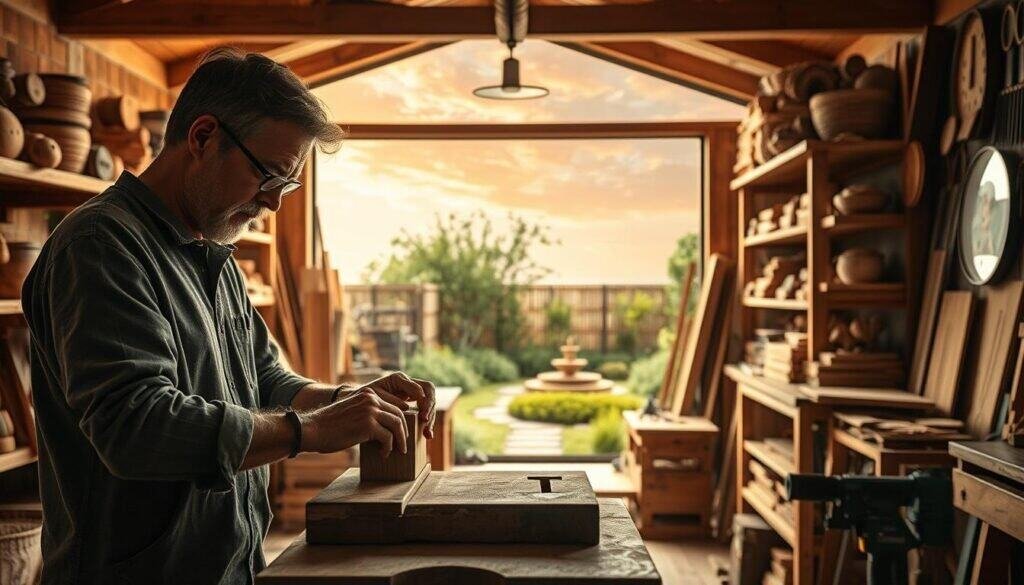
The tactile nature of woodworking is also therapeutic. Working with wood and tools provides a calming experience. It offers a break from daily stress.
Woodworking also improves cognitive skills. It enhances problem-solving and cognitive flexibility. These benefits are great for those facing mental health challenges.
The Therapeutic Benefits of Woodworking: Stress Relief & Creativity
Woodworking can change your life, giving you a break from daily stress and boosting your creativity. Making something with your hands is a special way to express yourself and relax.
More and more people are turning to woodworking as a way to unwind. It requires you to focus on your project, which can take your mind off worries. Many find it helps them feel calm and less anxious.
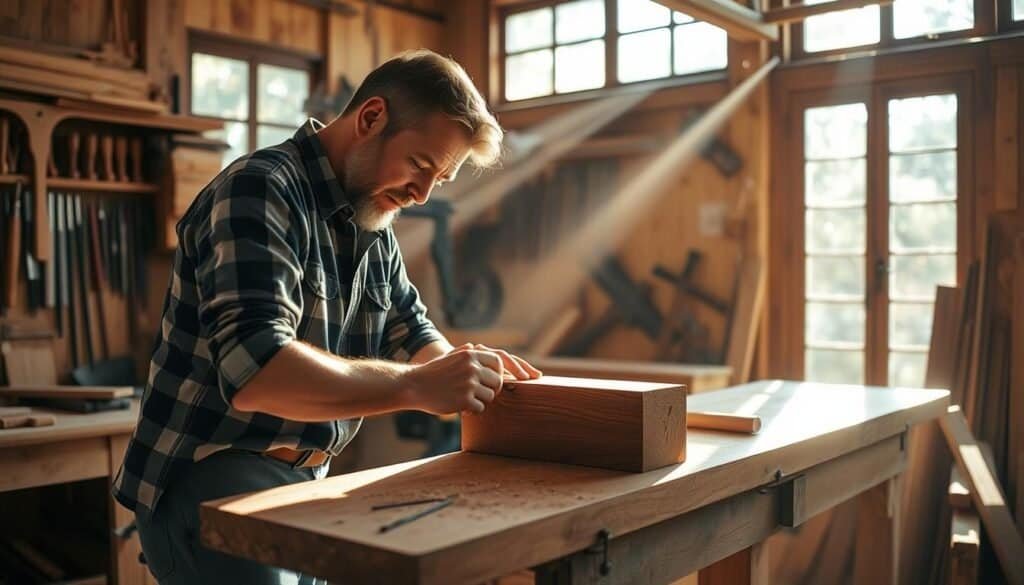
Woodworking helps with stress and boosts creativity. When you bring your ideas to life, you feel proud of what you’ve made. This encourages you to try new things and explore different techniques.
Woodworking also lets you share your feelings and thoughts through your work. Whether it’s a piece of furniture or a decorative item, creating something real can be very rewarding.
In short, woodworking has many benefits, like reducing stress and boosting creativity. It helps you find balance and fulfillment in life. By woodworking, you can experience these benefits for yourself.
Mindfulness Through Woodworking: Being Present in the Moment
Woodworking can be a great way to practice mindfulness. It requires you to focus on what you’re doing. This helps you forget about the past or future and just be in the moment.
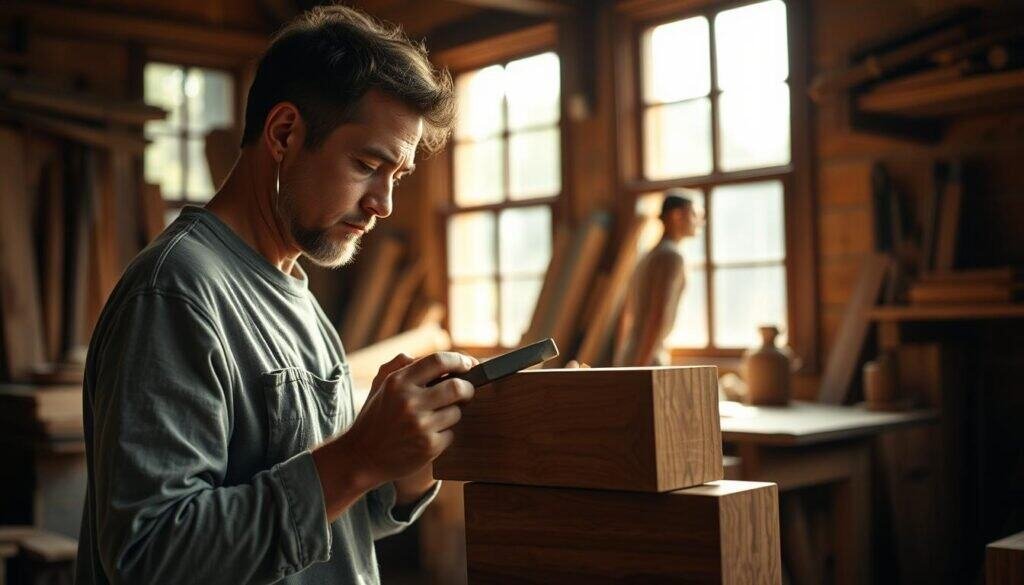
Creating something with wood needs a lot of attention to detail. This naturally makes you more mindful. When you’re measuring, cutting, and putting wood together, you can’t let your mind wander.
This mindfulness in woodworking can make you feel completely in the zone. You’ll feel calm and satisfied because you’re fully present.
Adding woodworking to your routine can make you more mindful in daily life. It helps you notice your thoughts and surroundings better. This way, you can handle life’s challenges with calm and clarity.
Physical Health Benefits of Woodworking
Woodworking offers many physical health benefits. It can improve your overall health in several ways.
One key benefit is better dexterity. Using tools and materials requires precision and coordination. This improves hand-eye coordination and fine motor skills.
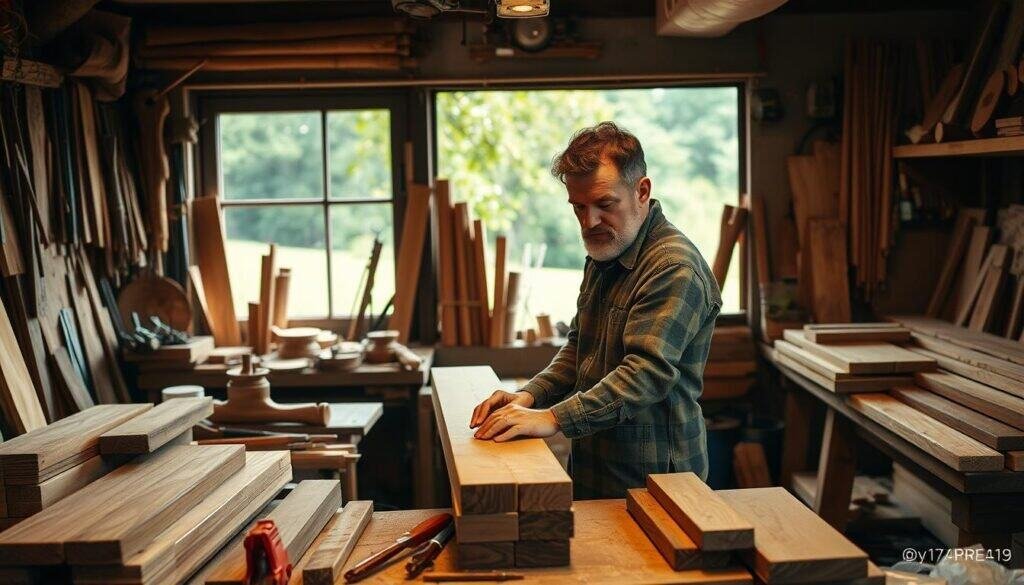
Woodworking also helps reduce health risks. The physical activity involved keeps you mobile and flexible. This can lower the risk of arthritis and other conditions.
Woodworking can be meditative, which helps lower blood pressure. This is good for your heart health.
Adding woodworking to your routine can boost your physical health. It’s a great way to improve your well-being.
Emotional Well-being and Woodworking for Mental Health
Woodworking is a great way to manage anxiety and depression. It’s a hands-on activity that lets people express their creativity. Working with wood can be very therapeutic.
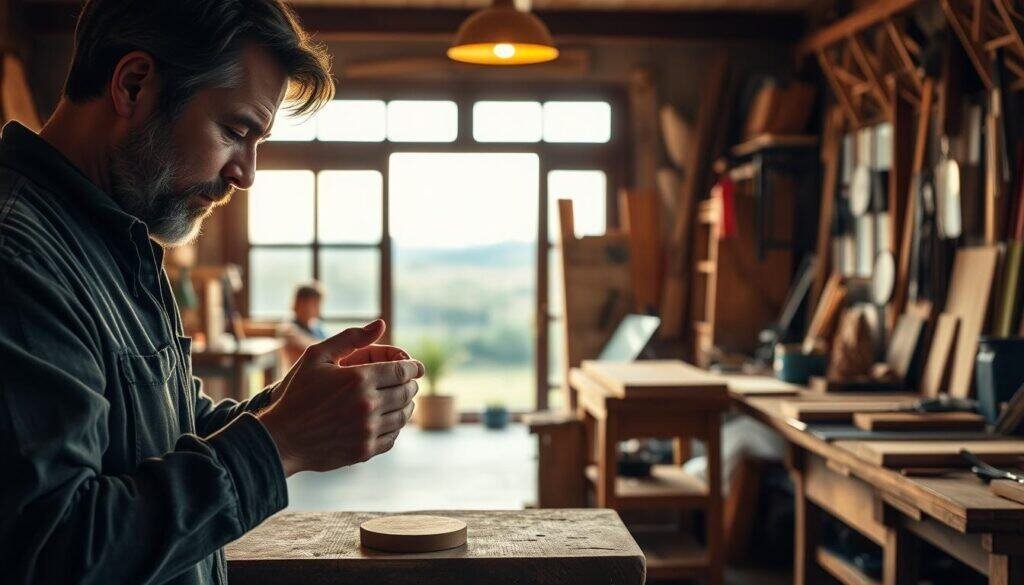
Creating something from wood can make you feel proud of your work. This feeling of accomplishment is key to emotional well-being. It lets people turn their emotions into something real and meaningful.
Woodworking also helps distract from daily stress. Focusing on the project can bring calm and peace. This is important for keeping emotions balanced.
Woodworking is a chance for self-reflection and mindfulness. As you work, you learn more about your thoughts and feelings. This helps you understand yourself better and your mental health needs.
Social Benefits: Building Community Through Woodworking
Woodworking is more than just a hobby; it’s a way to meet new people. Joining a woodworking community is a great way to find others who love woodworking as much as you do.
Woodworking communities have workshops, classes, and online forums. These places are perfect for beginners to learn from experts. You can share your projects, get feedback, and find inspiration.
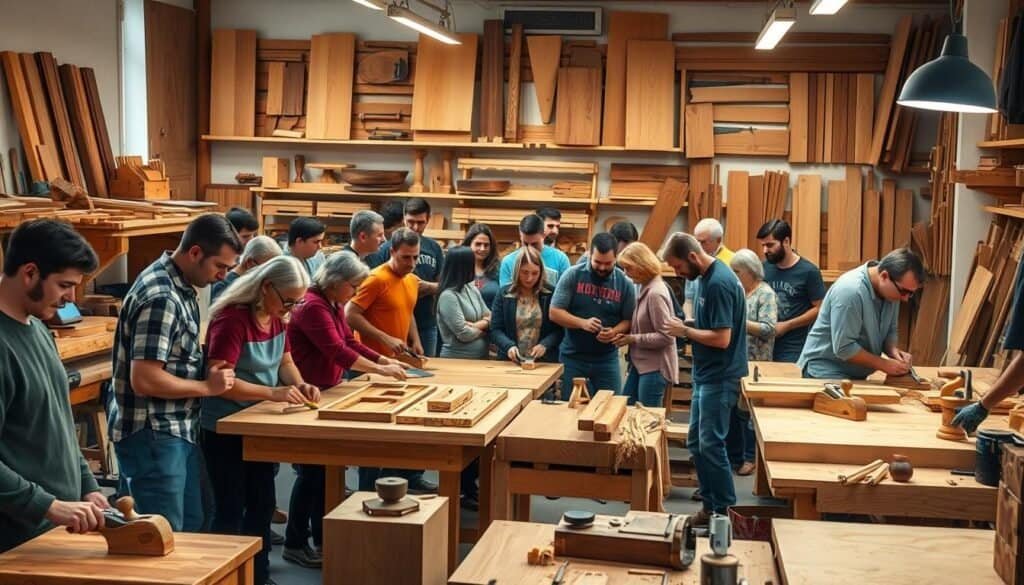
Working on beginner projects in a community setting is very helpful. It lets you practice, learn new things, and improve your skills in a friendly place.
Woodworking also helps you make friends and feel like you belong. It’s good for your mental health and happiness.
Being part of a woodworking community is rewarding. You can motivate each other, share tips, and enjoy working together on projects.
Getting Started: Essential Woodworking Tools for Beginners
Starting woodworking is more than just wanting to do it. You need the right tools to make your ideas real. For beginners, knowing the essential tools is key to starting projects.
Must-Have Measuring and Marking Tools
Woodworking needs accuracy, so measuring and marking tools are vital. You’ll need a tape measure, combination square, and marking gauge for precision.
A tape measure is great for big measurements. A combination square helps make sure corners are square and marks angles accurately.
Essential Cutting and Shaping Tools
Cutting and shaping wood are basic steps. You’ll need a table saw for straight cuts, a miter saw for angled cuts, and chisels for small wood removal and joints.
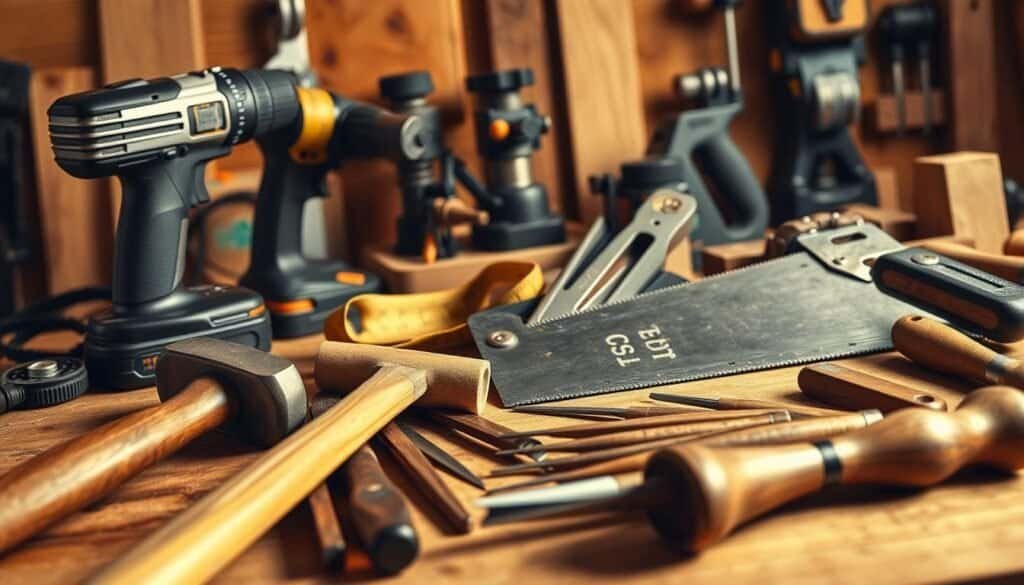
Finishing tools give woodwork a professional touch. Sandpaper smooths wood surfaces, and clamps hold pieces together while glue dries.
Knowing and using these tools improves beginner projects. Learning about woodworking jig plans also helps with complex projects.
By learning these tools and techniques, beginners can succeed and enjoy making things by hand.
Setting Up Your Therapeutic Woodworking Space
To enjoy the benefits of woodworking, having a dedicated space is key. A tidy and safe area makes your woodworking sessions better and more relaxing.
Start by making sure your space has good air flow and is free from clutter. Clutter can mess with your mind, taking away from the calm of woodworking. Use tools and materials that are easy to find. You can organize them with toolboxes, shelves, and pegboards.
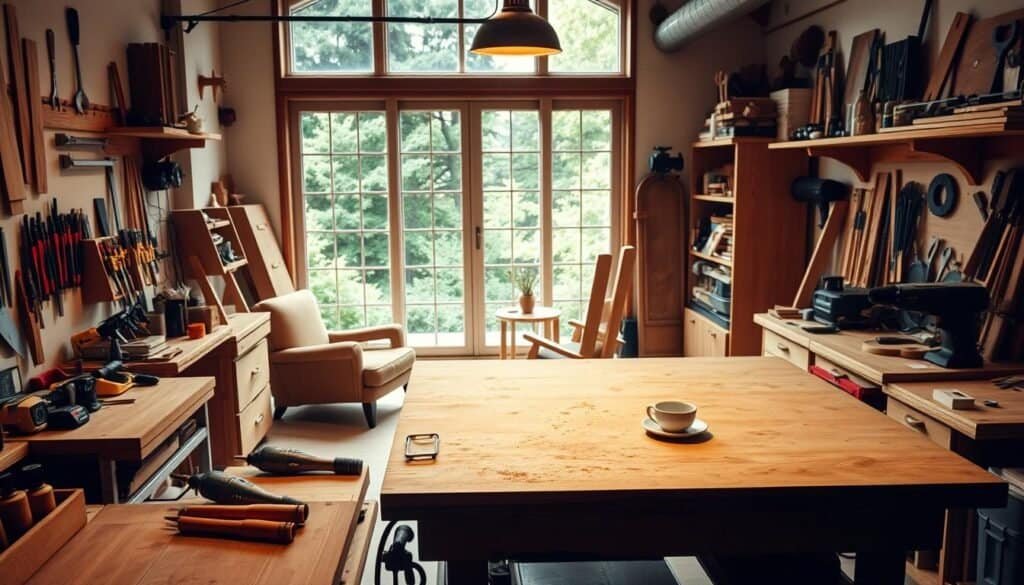
Safety is also vital in your woodworking space. Make sure you have safety gear like glasses, ear protection, and a dust mask. It’s also smart to have a first aid kit nearby.
Comfort is important too. Choose a good workbench and chair. Your space should also have enough light to avoid eye strain.
Make your space your own to make it welcoming and calming. Adding plants or art can turn your woodworking area into a peaceful place for creativity.
By following these tips, you can make a woodworking space that’s not just therapeutic but also a peaceful retreat from daily stress.
5 Simple Woodworking Projects for Stress Relief
Looking for a hobby that’s calming and fulfilling? Simple woodworking projects are a great choice. They offer a therapeutic escape, letting you express your creativity and reduce stress.
Here are five simple woodworking projects for stress relief:
1. Wooden Picture Frame – Making a wooden picture frame is easy. You just need to measure, cut, and assemble the wood. You can get creative with the wood type and frame design.
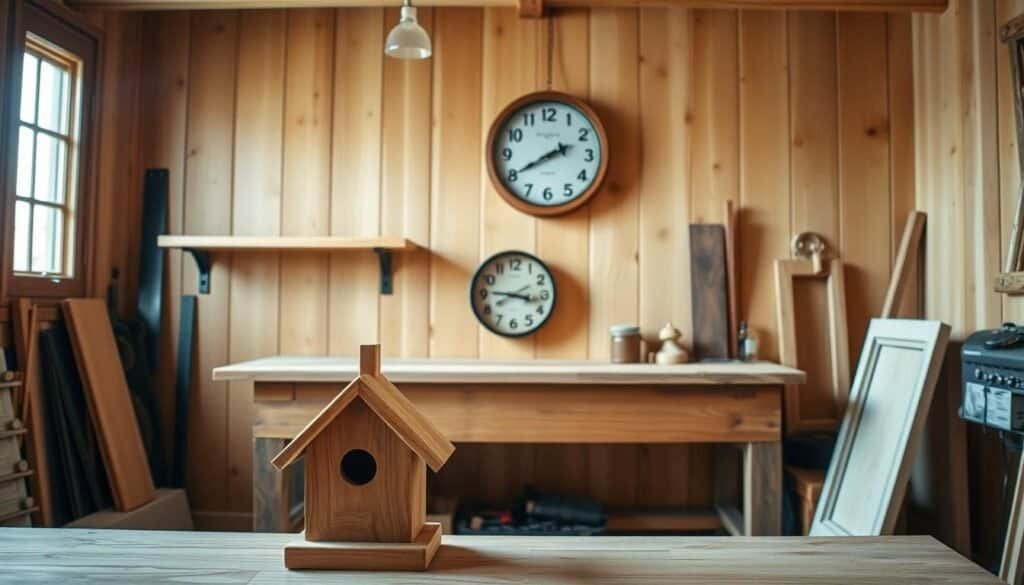
2. Birdhouse – Building a birdhouse is a simple yet rewarding project. It involves working with small wood pieces and creating a useful item. It gives you a sense of accomplishment.
3. Wooden Candle Holder – A wooden candle holder combines function and beauty. You can try different wood finishes and designs.
4. Simple Shelves – Building simple shelves is practical and useful. It helps improve your workspace or living area. It’s a chance to practice measuring and cutting wood.
5. Wooden Coasters – Making wooden coasters is a small but satisfying project. It involves working with small wood pieces and applying finishes. This protects the wood and makes it look better.
These simple woodworking projects do more than just offer a creative outlet. They help you find stress relief and relaxation. By creating something with your hands, you can feel calm and fulfilled.
Woodworking Techniques for Mindfulness and Relaxation
Woodworking can help you find peace and focus. Using hand tools makes you pay close attention. This helps you stay in the moment.
Sanding is a great way to relax. The smooth motion of sandpaper over wood is calming. It helps quiet your mind and lowers stress.
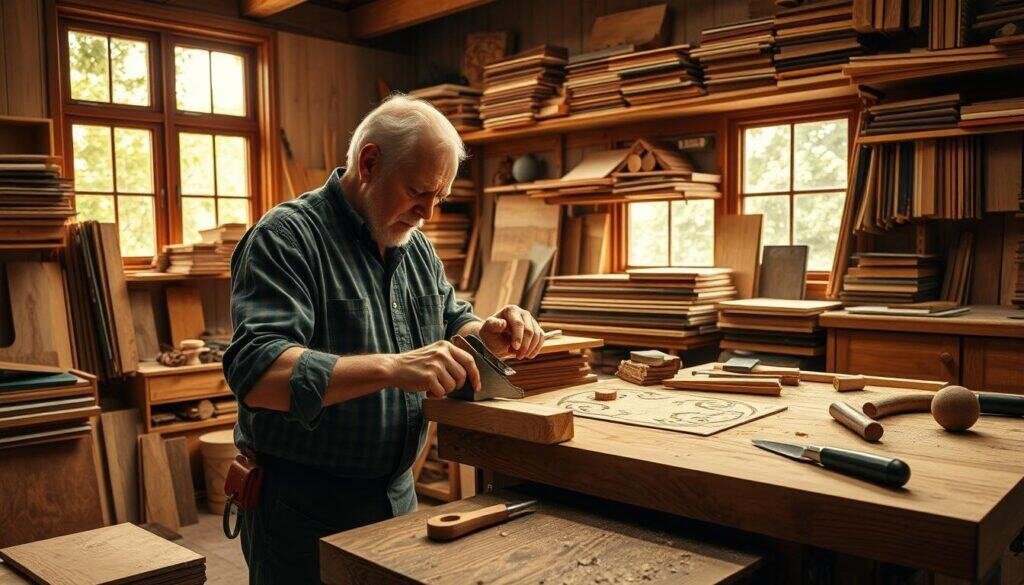
Hand saws also bring calm. Cutting wood slowly requires patience and focus. It connects you to the wood and the task, promoting mindfulness.
Learning to accept mistakes is key. It reduces stress and makes the process enjoyable. Embracing imperfections is part of the journey.
Adding these techniques to your routine can bring calm and happiness. As you practice, you may find peace in other parts of your life too.
Incorporating Woodworking into Your Self-Care Routine
Woodworking is a special way to mix creativity with self-care. It helps lower stress and boosts mental health.
To add woodworking to your self-care, plan a set time for it. It could be a few hours on weekends or a special evening each week. A regular schedule makes woodworking a habit, making it a fun, calming activity.
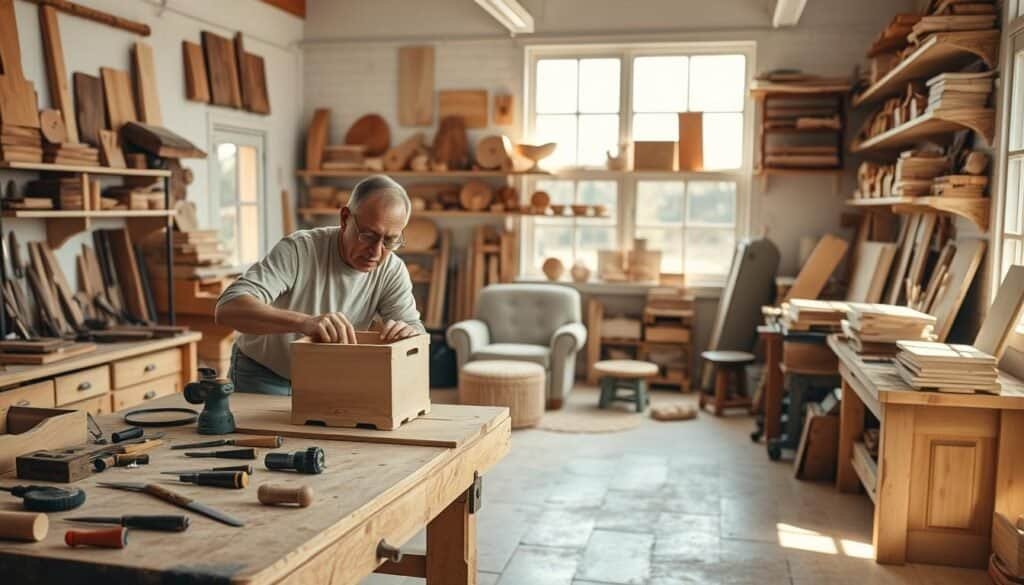
Start with easy DIY woodworking projects. They should not feel too hard. As you get better with tools and skills, you can try harder projects. The most important thing is to enjoy the journey, not worry about the end result.
Woodworking can make your life healthier. It’s about finding happiness in creating and using it to handle stress and better your mental health.
Overcoming Common Challenges in Therapeutic Woodworking
Therapeutic woodworking has many benefits but also faces challenges. These can include frustration with project results or feeling not good enough. The first step is to recognize these challenges.
One big challenge is feeling upset when projects don’t turn out as hoped. Setting realistic goals and knowing mistakes are part of learning can help. Using 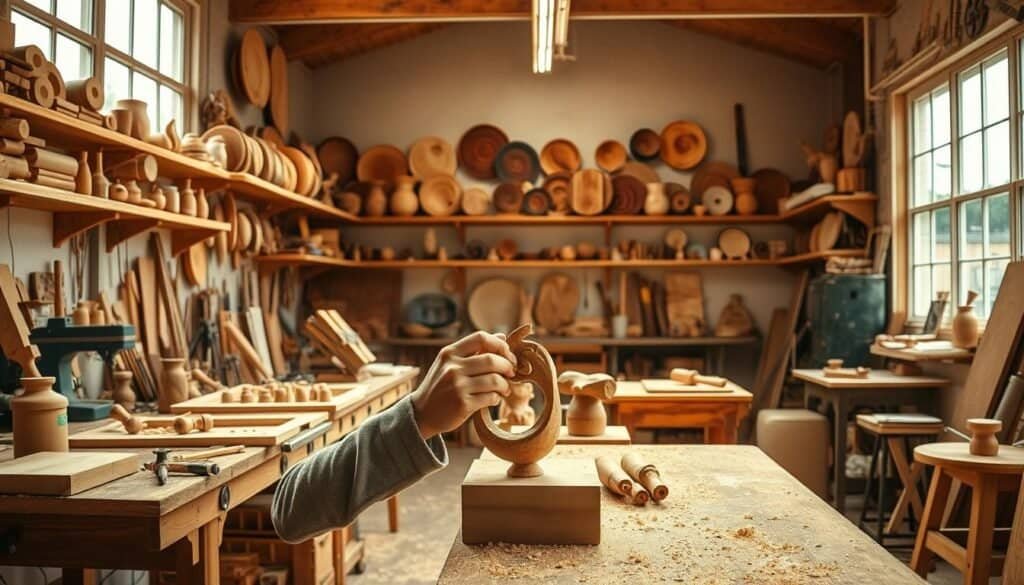 free woodworking plans can guide beginners through projects that are both achievable and rewarding.
free woodworking plans can guide beginners through projects that are both achievable and rewarding.
Feeling not good enough is another challenge, often for beginners. It’s important to see the value in the process, not just the end product. Focusing on the joy of creating and the stress relief it brings can shift our focus.
To tackle these challenges, joining a woodworking community or finding a mentor is helpful. Sharing experiences and learning from others can offer support and encouragement. Celebrating small wins can also boost confidence and highlight the benefits of woodworking.
By facing these challenges head-on and finding ways to overcome them, we can fully enjoy the benefits of woodworking. This enhances our well-being and creative expression.
Woodworking for Different Mental Health Needs
Woodworking can help with anxiety and depression. It can be made to fit each person’s needs. This way, everyone can find a way to benefit from it.
For those with anxiety, small woodworking tasks can be calming. Activities like sanding or making precise cuts can be soothing. They help focus the mind and lower anxiety.
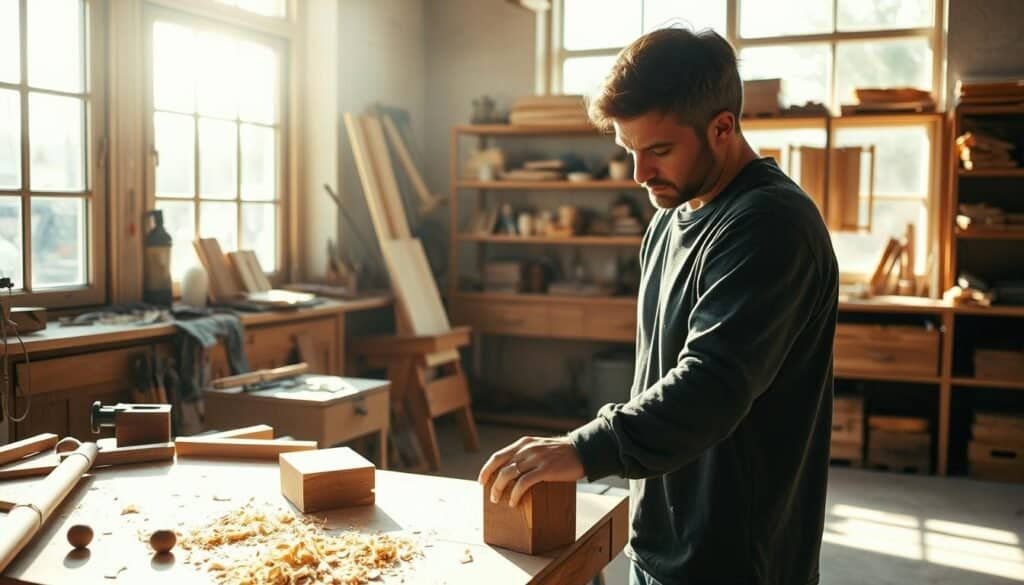
Woodworking can give a sense of achievement to those with depression. Finishing a project boosts confidence. It shows what one can do, which is very uplifting.
Woodworking is also a safe place for those who have been through trauma. It lets them express feelings without words. This can be very healing.
By making woodworking fit each person’s needs, it can be even more helpful. It doesn’t matter if it’s a small project or a big one. The goal is to create a space where mental health can improve.
Stories of Transformation: Real People Finding Healing Through Woodworking
Woodworking has helped many find peace and healing. People from all walks of life have turned to it for stress relief and mental health support.
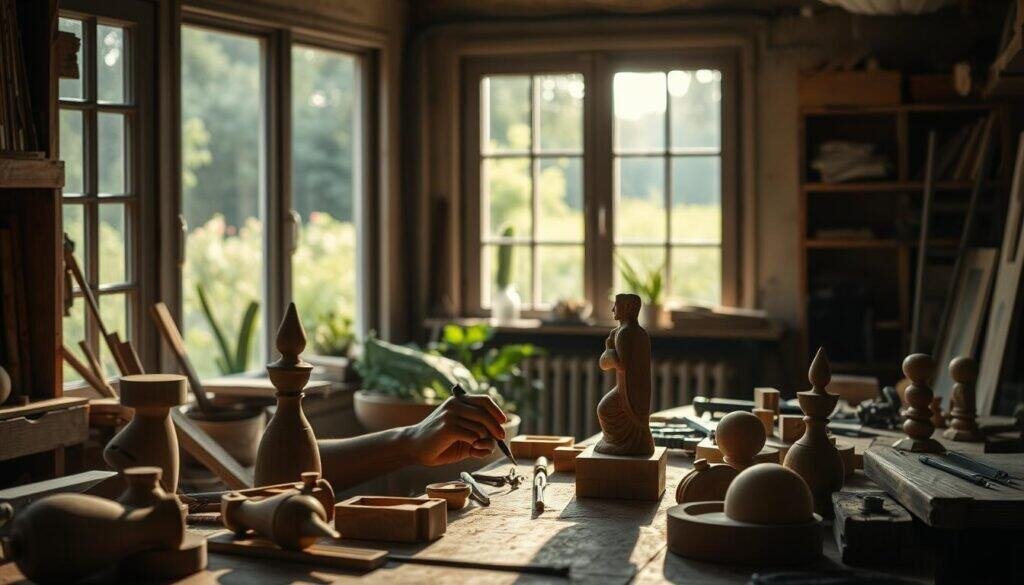
One person found comfort in woodworking after a big life change. They enjoyed designing and making wooden items. This gave them a sense of control and helped them heal.
Another person used woodworking to manage their anxiety. They found peace by focusing on the details of their projects.
These stories show how woodworking can change lives. It lets people feel proud and fulfilled, boosting their well-being.
As more people try woodworking, its healing power is becoming clear. It offers a way to express oneself and find peace, whether through simple or complex projects.
Sustainable and Eco-Friendly Approaches to Therapeutic Woodworking
Woodworking meets sustainability, creating a path to better mental health and a greener planet. More people are finding woodworking as a way to relax. It’s important to do it in a way that’s good for the environment.
Using reclaimed or recycled materials is a big step towards being eco-friendly. Pallets, for example, can be turned into creative projects. Scrap wood can also be used to make unique items, from decorations to furniture.
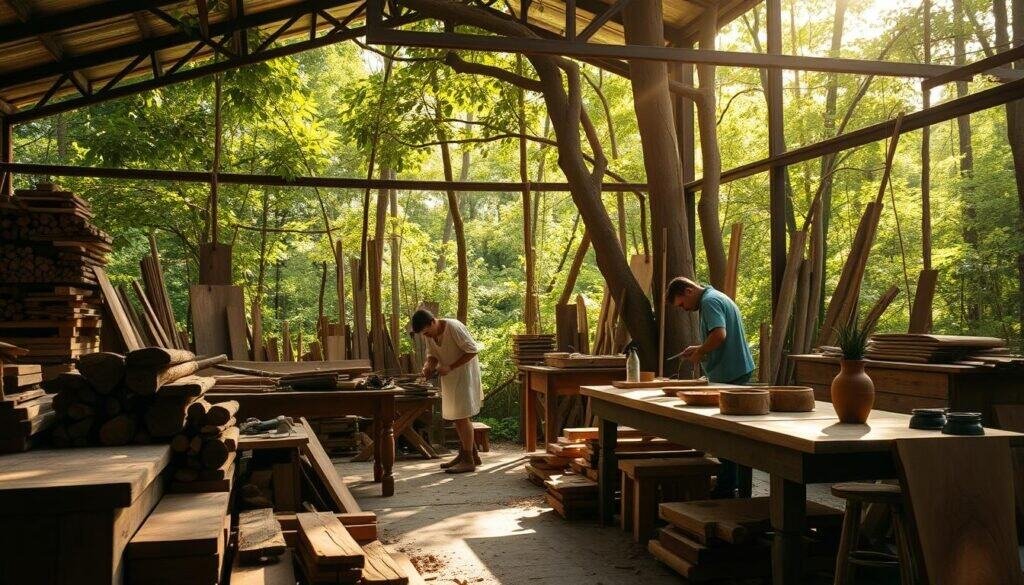
Choosing wood from local sources is another way to help the planet. It supports local businesses and cuts down on transportation pollution.
Woodworking workshops can also be made more sustainable. Using tools that save energy and reducing waste are key. Properly disposing of wood scraps and chemicals is also important.
Embracing sustainable woodworking makes the craft even more rewarding. It helps the planet and gives woodworkers a sense of purpose. This makes the woodworking experience even more fulfilling.
Conclusion: Embracing Woodworking as a Lifelong Therapeutic Practice
Woodworking brings many benefits, like stress relief and boosting creativity. It also improves physical and emotional health. By taking up woodworking, people can start a lifelong practice that strengthens their mind and heart.
Woodworking lets people express themselves creatively, leading to a sense of pride and confidence. It’s a healthy way to deal with feelings, reducing anxiety and depression.
Adding woodworking to your daily routine can bring happiness and support your mental and emotional health. Whether you’re new to woodworking or have been doing it for years, it can greatly improve your well-being.
